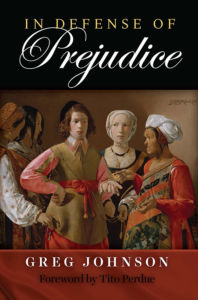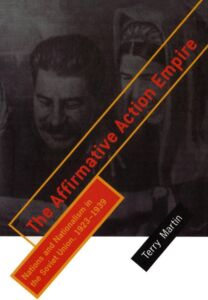Stalin’s Affirmative Action Policy
Terry Martin
The Affirmative Action Empire: Nations and Nationalism in The Soviet Union, 1923-1939
Ithaca, N. Y.: Cornell University Press, 2001
Empires are based on a core ethnic group with a well-organized military, a robust economy, and a functional government whose history of fairmindedness and even judgement is such that those outside the core ethnic group can put their trust in it. The Russian Empire, which was based on the Russian ethnic group, was such an entity. In 1917, the Russian Empire was overthrown by a mostly Jewish-organized revolution led by Vladimir Lenin. After a civil war, this Empire was replaced by the Soviet Union, a Jacobin polity based on the ideology of Communism.
“Had Lenin lived to write a theoretical account of his creation,” writes Terry Martin, “he might have called it The Soviet Union, as the Highest Stage of Imperialism” (p. 80). The Soviet Union was indeed an empire, but it was not a traditional one. It officially disavowed empire-building, but inherited an empire and was based on an expansionist Communist ideology. Communist dogma also held, put simply, that societies needed to achieve a national consciousness before reaching Communism’s final, utopian stage. The Soviet leaders nevertheless believed that nationalist sentiment was a “bourgeois trick” which kept the proletariat from obtaining class consciousness. The Soviet leaders likewise feared that Great Russian nationalism could overturn the Soviet government.

You can buy J. A. Nicholl’s short story collection Venus and Her Thugs here.
To paper over the contradictions in the Communist system and prevent a Russian nationalist revolution, the Soviet government created what could be termed an Affirmative Action Empire. Terry Martin takes the United States government’s “civil rights” policy of deliberately selecting non-whites for various positions and draws parallels with what happened in the Soviet Union a century ago. The Soviet elite’s policy was called korenizatsiia, or indigenization.
The Soviet Union’s leadership consisted of a hostile elite whose members were mostly not ethnically Great Russian. As a result, the Soviet leaders created organizations and policies which specifically favored non-Russians. In that America has a hostile elite who are mostly not Anglo-Americans, and that elite suppresses white, Anglo-American political organization, drawing parallels between the early Soviet Union and current America is certainly warranted.
Korenizatsiia, Soviet “Affirmative Action”
The ideal manifestation of Soviet-style, korenizatsiia affirmative action was to have a particular ethnic group that was secure in a Soviet Socialist Republic, subordinate to the central government in Moscow, supportive of Communist ideological aims, and conducting local business in the local vernacular while doing national-level business in Russian. This implied that an existing pro-Communist, educated, bilingual elite existed, and that this elite ruled over a population which did not feel threatened by Russians or Russian culture.
Ideal korenizatsiia was therefore restricted to nations which were European or Indo-European, as well as Orthodox Christian. The Georgian and Armenian SSRs were able to properly achieve Moscow’s ideal form of korenizatsiia. The Soviets attempted to apply “affirmative action” in the Ukrainian SSR, but the ethnic tensions between both the Russians in Ukraine and the multicultural Soviet central government with the Ukrainians became so poisonous that the korenizatsiia project started to unravel there.
Ukrainian-Russian tensions didn’t materialize out of thin air. They were greatly exacerbated by Soviet “affirmative action.” Korenizatsiia aimed to make it such that the language of government and business in the Ukrainian SSR would be conducted entirely in the Ukrainian language. The language of the cities and industrial areas in the Ukrainian SSR was Russian, however, while the language of the villages was Ukrainian. Western Ukraine was also more Ukrainian-speaking and aligned with Catholicism religiously, while eastern Ukraine was Russian-speaking and Orthodox. Most factory managers and Communist party cadres in the Ukrainian SSR spoke only Russian and greatly resented being forced to learn Ukrainian. All of this played out at a time when food supplies were uncertain, and when civil war and counter-revolution lay in the very recent past.
East & West
The ethnic Great Russians started to build settlements across the Ural Mountains in the twelfth century. By 1917, Russian communities were well established across all northern Eurasia. The Great Russians had also settled in places such as Kirgizstan and Kazakhstan. The expansion of the Great Russians parallels that of the Anglo-American whites in that both Indo-European peoples built prosperous farms on land inhabited by culturally primitive, racially Asiatic Siberians or Amerindians.
The Great Russians’ settlements outside the Russian Soviet Federal Socialist Republic (RFSR) were seen by the non-Russian Soviet elite, through their ideological lens of Communism and anti-Russian ethnic animus, as illicit colonialist projects. The Soviet elite couldn’t fully dispossess the Great Russians, however. Russians were simply too numerous and too productive.
While Russians, Georgians, and Armenians represented a high culture, the Asiatic peoples of the Soviet Union were backwards by nearly every measure. Consequently, the Soviet elite’s “affirmative action” policy came to be divided into western and eastern parts. Ukrainians, Belorussians, Armenians, and Georgians fell into the western category, while the Asiatic backwards nations joined the eastern category. Crimean Tartars, although west of Armenia and Georgia, were considered “eastern.”
The designation of “backwardness” was as much a boondoggle as scholarships given to “Amerindians” are in present-day America. Eskimos living in the Russian High Arctic were genuinely “backwards,” of course. But the Soviet government also designated Greeks, Assyrians, and Persians as “backwards.” Including the later three ethnic groups in a privileged category demonstrates that market-dominant minorities such as the Assyrians had just as much of an ability to capitalize on every advantage after the revolution as before.
The effects of the eastern-style korenizatsiia fell into three categories:
- The Tartar variant: These areas had a long-established Russian presence. Ethnic tensions were confined to control over those white-collar jobs that had some connection to the Soviet bureaucracy. Violent ethnic conflict was entirely absent.
- The Kazakh variant: Settlement of Great Russians or other Slavic people was recent, and the native Asiatic tribes were poor. In this case, indigenous government officials moved against ethnic Great Russians at every opportunity. Ethnic conflict between Slavs/Russians and Asiatics was widespread and violent.
- The Uzbek variant: These areas had a low level of Great Russian colonization and low economic and cultural development in general. Ethnic conflict centered on the exact border between the various Central Asian Soviet Socialist Republics. Where the border crossed two different ethnicities, trouble followed.

You can buy Greg Johnson’s In Defense of Prejudice here
While Soviet sympathizers in the United States, often Jews, damaged white American interests by critiquing segregation’s alleged evils in the 1920s and t30s, the Soviet Union practiced segregation of its own between Europeans and Asiatic natives at job sites in Central Asia. Great Russians, Slavs, and assimilated Tartars enjoyed better food, wages, and living conditions than the native Kazakhs, Uzbeks, and Kyrgyz.
This “affirmative action” policy also created the opportunity for the various nationalities to change their alphabets. Islamic nations in the Soviet Union switched from the Arabic script to the Latin one. In an ominous omen, the Islamic nations rejected the Cyrillic alphabet, as they saw it as being associated with (Orthodox) Christian missionary activity.
Soviet linguists also put forward a plan to Latinize the Belorussian and Ukrainian alphabets so as to make Communist and pro-Soviet metapolitical inroads into Poland. The Soviets discovered that cross-border connections in the west were undermining rather than expanding Soviet influence, however. Linguists in the Western areas who sought to create a Latin alphabet were ousted from government jobs during the Stalinist purges.
Soviet “Affirmative Action” Unravels
The “affirmative action” empire started to unravel in Ukraine in the late 1920s, when a Communist Party official named Alexander Shumskyi feuded with a Communist Jew named Lazar Kaganovich over what Shumskyi saw as the slow pace of Ukrainization. This argument came to be called the Shumskyi affair, and it pitted Ukrainian and multicultural Soviet Communists against each other along ethnic lines. Both men appealed to Stalin, but Kaganovich had more supporters and Shumskyi was forced into exile in Leningrad. He was later imprisoned and executed in 1946.
Martin writes:
To sum it up, an anti-korenizatsiiahard line gradually emerged during the long Shumskyi affair. It consisted of a growing belief that korenizatsiia was exacerbating rather than defusing nationalism. Korenizatsiia abetted national communists, in introducing non-Bolshevik nationalist concerns into the party and society, such as Shumskyi’s concern with who was a true Ukrainian . . . Moreover, the initial foreign policy advantages of Ukrainization in attracting West Ukrainian support [in Poland and Europe] for Soviet Ukraine proved illusory, since making nationality the central aspect of cross-border ethnic influence allowed West Ukrainian nationalists to exert an increasing influence on Soviet Ukraine. (p. 228)
In 1928, Stalin made a careful assessment of the Soviet Union and shifted policy towards greater central government control as a defensive measure. This policy was expressed in a government-led industrial expansion and the collectivization of agriculture. This policy also further unraveled korenizatsiia. The tensions over language in Ukraine created an enormous pro-Russian pushback within the Communist Party itself.
There were other advantages to aligning the Soviet Union with the interests of the ethnic Russians. Unlike the other nationalities, Russians had few cross-border ties to other sovereign nations and thus could not be influenced by foreign governments. Rapid industrialization and agricultural collectivization were not also resisted by Russians, possibly because these policies were carried out in such a way as to align with ethnic Great Russian sensitivities. Finally, the Communist theory of international class consciousness failed to materialize, and thus aligning the Soviet Union with ethnic Russians became the only way forward.
Enemy Nations
The controversy over the pace of Ukrainization and the Soviet government’s agricultural policies led to a man-made famine in the Ukrainian SSR between 1932 and 1933. Concerning this, Martin writes:
Nationality was of minimal importance . . . The Famine was not an intentional act of genocide specifically targeting the Ukrainian nation. It is equally false, however, to assert that nationality played no role whatsoever in the famine. The nationalities terror resulted from the gradual emergence of an anti-korenizatsiia hardline critique combined with the immediate pressures of the grain requisitions crisis in Ukraine and Kuban, whose particularly intense resistance was attributed to Ukrainization. (p. 305)
By the mid-1930s, the international situation was such that the Soviet government shifted from its utopian “affirmative action” policies to a defensive posture; Stalin created a list of “enemy” nations and acted accordingly. During the 1920s, some of these “enemy” nations had thrived under korenizatsiia. The Finns of Ingria (the Baltic region north of Leningrad) increased their numbers by encouraging ethic Finns from America to relocate. Stalin designated Poles, Germans, Finns, Estonians, Latvians, Koreans, Chinese, Kurds, and Iranians as enemies. People from these groups were ethnically cleansed from the border regions. Eventually the deportations expanded to Crimean Tartars, Greeks, Armenians, Bulgarians, Meskhetians, Turks, and Black Sea Khemshils.
The end of korenizatsiia heralded a new equilibrium in the Soviet Union. The non-Russian nationalities were encouraged to communicate in their respective mother tongues and celebrate their cultures, but participating in the Soviet system at the national level had to be conducted in Russian. The Soviet Union had gone full circle, reverting to an empire based on a particular ethnic core.
The Soviet Union never fully reconciled itself with the Russian nation, however. Martin writes:
There was, in fact, never a good place for the Russian nation. They were always the Soviet Union’s awkward nationality, too large to ignore, but likewise too formidable to give the same institutional status as the Soviet Union’s other major nationalities. (p. 395)
Unsurprisingly in light of this, when hardline Communists attempted to launch a coup in Moscow in order to prevent collapsing Soviet Union from disappearing altogether, Russia’s newly-elected President, Boris Yeltsin, declared the independence of the Russian Soviet Federal Socialist Republic and used it to finally kill the USSR once and for all.


